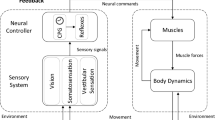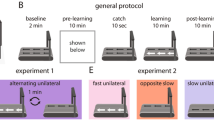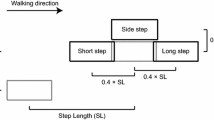Abstract
After stepping in place on a rotating treadmill, individuals exhibit involuntary turning in the direction opposite treadmill rotation when stepping in place on a stationary surface without vision. This response is called podokinetic after-rotation (PKAR). It remains unclear where the control center for PKAR is located and whether separate, independent podokinetic control centers exist for each lower limb. To better understand neural mechanisms underlying locomotor trajectory adaptation, this study asked whether PKAR transfers between lower limbs. Thirteen healthy adults underwent separate 15-min sessions where one (trained) leg or both legs stepped on the rotating surface. Afterward, all subjects exhibited PKAR during one-legged hopping on a stationary surface, whether hopping on the trained or untrained limb. There were no significant differences in mean turning velocity across conditions. Our results support the absence of independent podokinetic control centers for lower limbs, indicating that a single center may control locomotor trajectory.


Similar content being viewed by others
References
Anstis S (1995) Aftereffects from jogging. Exp Brain Res 103:476–478
Choi JT, Bastian AJ (2007) Adaptation reveals independent control networks for human walking. Nat Neurosci 10(8):1055–1062
Durgin FH, Fox LF, Kim DH (2003) Not letting the left leg know what the right leg is doing: Limb-specific locomotor adaptation to sensory-cue conflict. Psychol Sci 14:567–572
Earhart GM (2006) Walking and running on the circular treadmill: Transition speed and podokinetic aftereffects. J Mot Behav 38:349–356
Earhart GM, Hong M (2006) Kinematics of podokinetic after-rotation: similarities to voluntary turning and potential clinical applications. Brain Res Bull 70:15–21
Earhart GM, Jones GM, Horak FB, Block EW, Weber KD, Fletcher WA (2001) Forward versus backward walking: transfer of podokinetic adaptation. J Neurophysiol 86:1666–1670
Earhart GM, Fletcher WA, Horak FB, Block EW, Weber KD, Suchowersky O, Melvill Jones G (2002a) Does the cerebellum play a role in podokinetic adaptation? Exp Brain Res 146:538–542
Earhart GM, Jones GM, Horak FB, Block EW, Weber KD, Fletcher WA (2002b) Podokinetic after-rotation following unilateral and bilateral podokinetic stimulation. J Neurophysiol 87:1138–1141
Earhart GM, Jones GM, Horak FB, Block EW, Weber KD, Fletcher WA (2002c) Transfer of podokinetic adaptation from stepping to hopping. J Neurophysiol 87:1142–1144
Earhart GM, Sibley KM, Horak FB (2004) Effects of bilateral vestibular loss on podokinetic after-rotation. Exp Brain Res 155:251–256
Gordon CR, Fletcher WA, Jones GM, Block EW (1995) Adaptive plasticity in the control of locomotor trajectory. Exp Brain Res 102:540–545
Gordon CR, Tal D, Gadoth N, Shupak A (2003) Prolonged optokinetic stimulation generates podokinetic after rotation. Ann N Y Acad Sci 1004:297–302
Hollands MA, Young WR, Chapman GJ (2007) The effects of podokinetic conditioning on static and dynamic posture. In: ISPGR International conference program and abstracts, p 154
Hong M, Perlmutter JS, Earhart GM (2007) Podokinetic after-rotation in Parkinson disease. Brain Res 1128:99–106
Jensen L, Prokop T, Dietz V (1998) Adaptational effects during human split-belt walking: influence of afferent input. Exp Brain Res 118:126–130
Jurgens R, Boss T, Becker W (1999) Estimation of self-turning in the dark: comparison between active and passive rotation. Exp Brain Res 128:491–504
Mergner T, Hlavacka F, Schweigart G (1993) Interaction of vestibular and proprioceptive inputs. J Vestib Res 3(1):41–57
Reisman DS, Block HJ, Bastian AJ (2005) Interlimb coordination during locomotion: what can be adapted and stored? J Neurophys 94:2403–2415
Reynolds R, Bronstein A (2004) The moving platform after-effect: limited generalization of a locomotor adaptation. J Neurophysiol 91:92–100
Reynolds R, Bronstein A (2007) The moving platform after-effect reveals dissociation between what we know and how we walk. J Neural Transm 114:1297–1303
Weber KD, Fletcher WA, Gordon CR, Jones GM, Block EW (1998) Motor learning in the “podokinetic” system and its role in spatial orientation during locomotion. Exp Brain Res 120:377–385
Acknowledgments
We would like to thank Mike Falvo, Heidi Schmidt, Josh Funk, and John Scott for their assistance in this project. This work was supported by NIH grant K01 HD048437-05.
Conflict of interest statement
The authors have no conflict of interest with respect to this work.
Author information
Authors and Affiliations
Corresponding author
Rights and permissions
About this article
Cite this article
McNeely, M.E., Earhart, G.M. Evidence for limb-independent control of locomotor trajectory. Exp Brain Res 201, 613–618 (2010). https://doi.org/10.1007/s00221-009-2075-z
Received:
Accepted:
Published:
Issue Date:
DOI: https://doi.org/10.1007/s00221-009-2075-z




